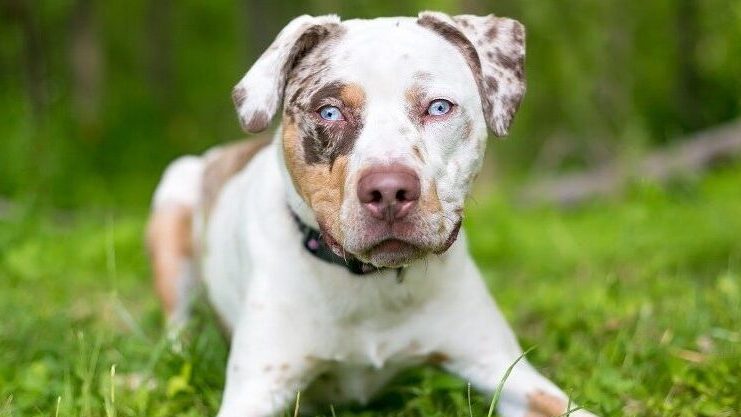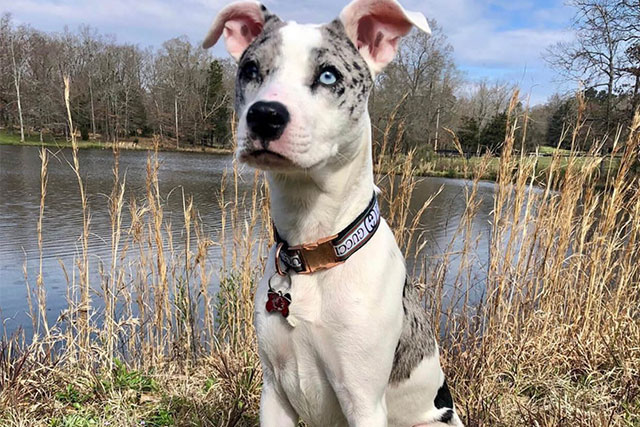Colors:
The Pit Catahoula coat color mainly depends on the Catahoula’s color genes. Since most Catahoula Leopard dogs are merle and or piebald, they pass down these colors to their mixed offspring.
The merle (M) and piebald (Sp) genes are dominant genes that cannot be inherited by a pup without being visible.
Most Pitbull Catahoula mixes have both the merle and piebald genes causing them to have a marbled merle pattern with white sections as described above. Piebald dogs may also have ticking spots which are tiny dark spots appearing on the white sections of the coat.
A unique feature of most Catahoula Pitbull eyes is their striking and alert light blue “glass eyes”. These blue eyes are caused by the actions of the merle and/or piebald genes.
Some of these crosses have two blue eyes, one blue eye (heterochromia), or part blue eyes where only part of one or both eyes are blue (cracked glaze). The bright blue eye appearance is random and varies from one dog to another.
The nose can be black, brown, bluish, or pale brown depending on the eumelanin color pigment.
As mentioned the merle and/or piebald gene can remove pigment from these crossbreeds’ noses causing them to have pinkish spots. Noses with pink spots or sections are known as butterfly noses.
Catahoula Leopard dog:
The Catahoula Leopard dog originally called Catahoula Leopard Cur is an intriguing breed that is not as popular as the Pitbull.
These dogs’ origins date back to the Lousiana Territory in the 1600s. They are believed to have been bred by Spanish Settlers as herding and hunting dogs by mixing Greyhounds, Mastiffs, Bloodhounds, and native breeds at the time.
The resulting offspring were then crossed with Beaurcerons by French fur trappers in the 1700s to give us the Catahoula we know today. Catahoulas were named the official Lousiana State dog in 1979.
Today, this is a versatile ranch dog that can serve as a herding, hunting, retriever, and watchdog. He is an active working dog fit for any purpose and best suited for active environments and families.
This is not a dog for everyone due to their high prey drive, strong will, independence, and territorial streak but in experienced hands, they are incredible. For a first-time dog owner or in an apartment, this pooch can be overwhelming.

Catahoula Pit Bull Mix Physical Appearance

The crossbreed comes in two different colours, often referred to as blue and red pits. The colour variations are seen in the skin, for instance, the nose and the feet.
You can also get some very pale dogs and very black Catahoula Pit Bull cross pups in a litter.
There is even sometimes the emergence of merle patterns, which can lead to some very unusual and attractive markings on these dogs. We have written another article about the Blue Merle Pit Bull, a possible parental breed for the Catahoula Pit Bull Mix.
The coat of this crossbreed is usually short and manageable, and shedding is low. It makes the Catahoula Pit Bull Mix a low maintenance dog when it comes to grooming.
The adult weight of this dog can vary and be anywhere between 35 and 82 pounds (16 to 37 kg).
It may depend on different factors, such as the gender of the dog, or which parental breed it leans more towards.
On average, the Catahoula Pit Bull Mix can reach a height of around 22 inches (56 cm).
Keeping all of this in mind, the overall look and physical appearance of a Catahoula Pit Bull Mix can vary a great deal.
You may end up with a dog that has a stocky build with the face of an American Pitbull, for instance, or a much leaner alternative.
Interesting and Shocking Facts about the Catahoula Pitbull mix | Should you get one for you?
Are you interested in finding out more about the elegant crossbreed that won many dog lovers’ hearts – the Catahoula Pit Bull Mix?
The Catahoula Pit Bull Mix is rare, but it is gaining popularity and has become better known outside of the USA recently.
This article will explore some of the most important aspects of owning a Catahoula Pit Bull Mix as a family pet. We will help you to make an informed choice in deciding whether Catahoula Pit Bull Mix is the right dog for you.